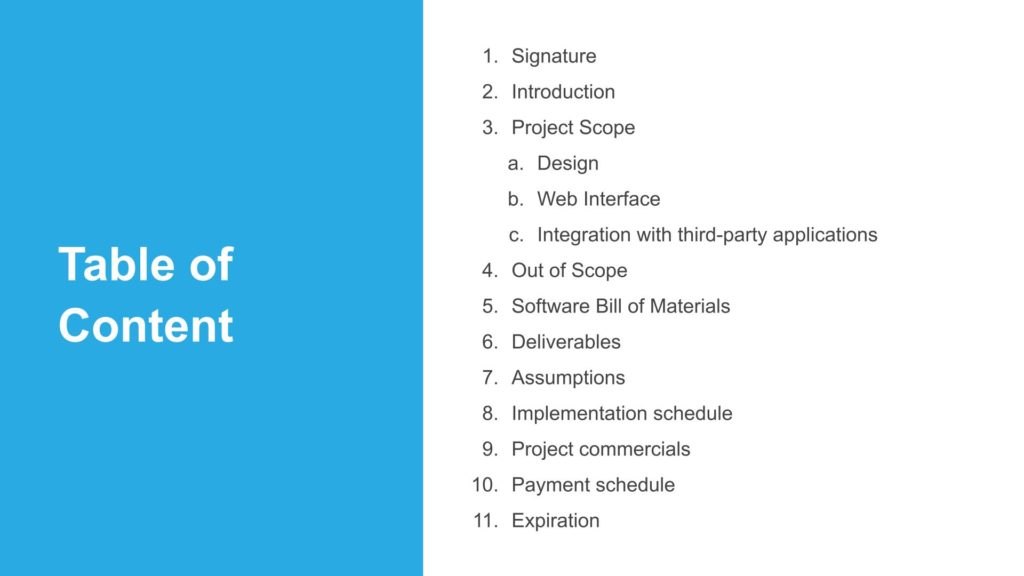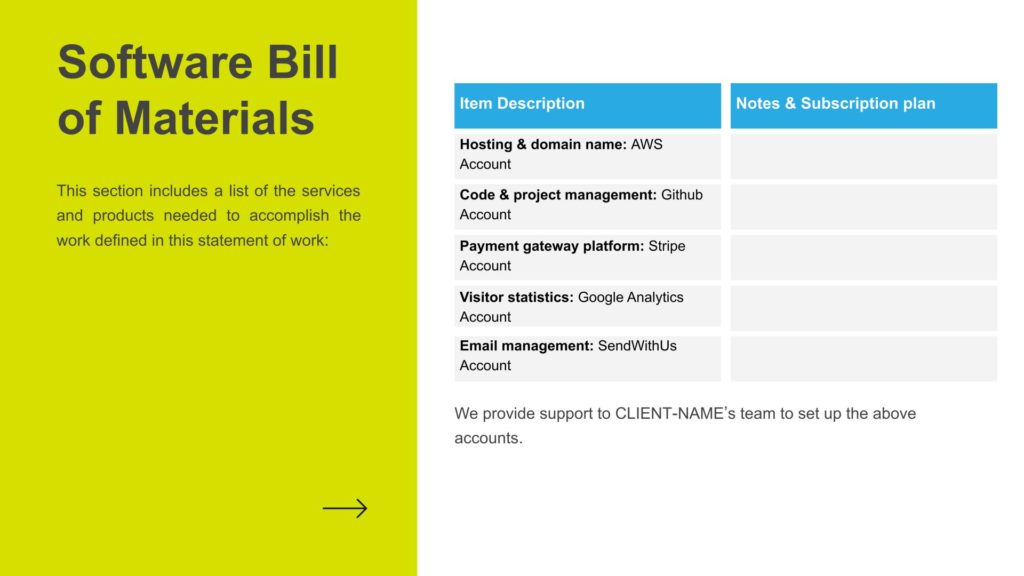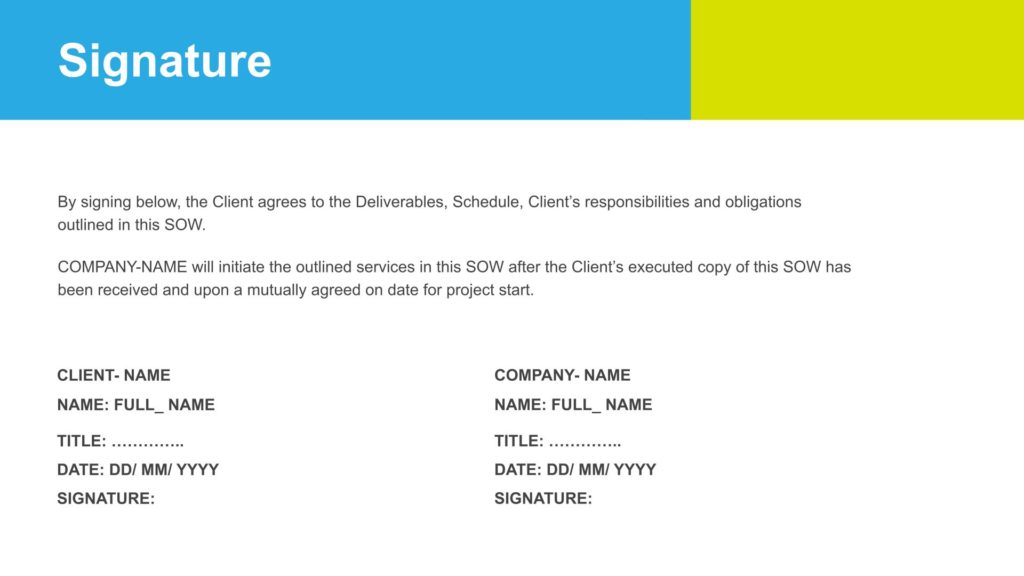First things first, let’s just put it out there: The Statement Of Work (SOW) is so often the one piece of documentation that saves you from a world of trouble since it helps guarantee your project work will be done according to certain guidelines and expectations. On the other hand, it can be the worst since it requires a lot of work to create it, and even then, just a tiny mistake can have massive repercussions.
In this Statement Of Work guide, we’re going to take you step-by-step through the process of producing an effective SOW. Plus, We’ll provide you with a free template so you’re set with everything you need to start working on your own SOW.
Why is it so important?
A Statement of Work is a perfect way to set the stage for an ideal business relationship: Think of it as an opportunity to show your competence and differentiate yourself since your client will surely be looking at multiple options, so it’s important to stand out.
On another note, it’s great to have an ongoing conversation with your client, but not everything can be clarified in person, and this where the importance of the SOW is showcased. It gives you a chance to shed light on the most delicate and specific parts of your relationship as well as reiterating any important information that you want your prospect to remember. Therefore, the Statement of work document should not be approached lightly. While you should aim to keep it as lean as possible, an SOW needs to be detailed and accurate: one tiny mistake could cause you a whole world of pain later on.
SOW provides the extra layer of detail that describes exactly what’s being done and delivered and what’s not, and as you specify this, you get an opportunity to refine your approach, and maybe even adjust your estimate and your timeline.
This level of detail provides reassurance to the client as to what will be delivered and sets up a shared understanding of what the project will ultimately achieve.
Who needs it?
A Statements of Work document is typically used when the work can be described according to specific directions or instructions, and when the requirements, tasks, and conditions are easily understood by both parties.
You should consider SOW as an organizational tool to capture the project’s critical work elements, which makes it useful in 2 situations: when contractors or collaborators outside your organization are working on a project with your internal project team or as an intermediate planning step for a large complex project where the work is being done internally.
You don’t need an SOW when your project is small and simple enough for you to directly translate your Scope Statement into your Work Breakdown Structure tool (e.g. MS Project).

At a minimum, the SOW document should clearly include in detail the following sections regardless of the industry or field:
Overview: What the project is, its purpose, and what it will achieve.
Project scope: Outlines the work that needs to be done and the processes involved in completing the work.
Out of scope: Tasks that are not included in the project scope and do not contribute to the project’s objective.
Schedule & Tasks: When the project will be delivered, along with a timeline and a list of milestones, including the approximate amount of time for each milestone, as well as approximate start dates and end dates.
Deliverables: What will be achieved.
Work requirements: Any requirements and specifics about how the project is to be completed, such as hardware and software will be used.
Cost & Payment: How much the project will cost, as well as a payment schedule
Signature: This section signifies that all parties agree to the stipulations of the SOW.

In fact, you could put all kinds of details into your Statement Of Work if you wanted, it’s just best to keep it as lean as possible.
How to write it?
Your SOW should be created just before your project kick-off, but not while the client is still deciding what it is they want. So get it approved first.
Additionally, the SOW should only be written after terms and guidelines have been decided and agreed upon, detailing specific tasks, deliverables, and/or services the contractor is responsible for. This will help you avoid conflicts when negotiating the contract.

To make your SOW more manageable, use the following tips:
Be specific: Leave no room for interpretation or ambiguity.
Break it up: You can split your SOW into sections, phases, milestones, etc. and you can even break down those phases for an easy creation process.
Lay down the ground rules: Make sure everyone knows what’s expected and what’s not.
Make it clear: This is no time for complicated language or business buzzwords. If there are technical terms, provide a glossary. Remember, this is a document for your client as much as it is for your team.
Get buy-in: Make sure everyone understands and agrees on the SOW.
Share it: Share the document with everyone and make it easy to access.
Own it: Whether you made it yourself or co-wrote it, it’s important to familiarize yourself with every detail before the project begins. Knowing the project inside-out not only helps you manage yourself but also makes you look organized and professional both within your team and in front of the client.
Use it: There’s no point going through all the effort of creating an SOW only to let it gather dust somewhere. It’s important that you, your team, and your client refer to it throughout the entire project.
The challenging question for project managers when writing the statement of work is deciding how much detail to include. If you’re too scant in the details, it will leave a lot to interpretation so there will be room for flexibility to maneuver and pivot, but it will also present an opportunity for a client to try their luck in getting more things done out of the project scope.
On the other hand, include too many details in the Statement Of Work (SOW) and you’ll find yourself stuck with a rigid process and deliverables that might not be adding to the overall value of the project.
You need to strike the balance of making sure the statement of work is precise and right on point while still ensuring that you’re addressing and covering all potential problem areas.
Finally, remember that the first version of your plan is your baseline as it outlines every step you need to take to get from the beginning to the end of your project. You don’t just skip or improvise steps and phases to get the wanted results.
Our final tip would be to ask for help when you need it: If this is your first time creating a statement of work find someone with experience and ask them to mentor you throughout the process if possible, their support will give you extra confidence. You may also need to consider hiring a technical writer for some sections, especially related to software development.
